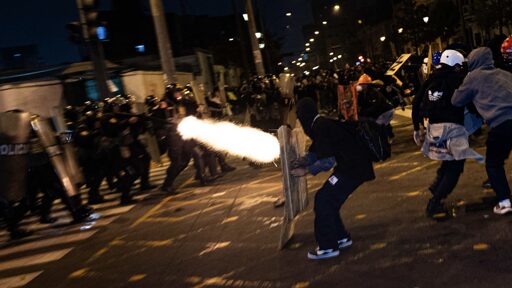Peru’s right-wing Congress gambled that their removal of highly unpopular Dina Boluarte and the subsequent swearing in of José Jerí as President of Peru would perhaps bring down the intensity of the protests in the country and ultimately lead to their dissipation.
However, in Lima (the capital) and other cities such as Arequipa, Cusco, and Puno, protests have continued and even grown in strength. The state repression of the protests also appears to be a constant, as this too has persisted and intensified. According to human rights organizations and local media outlets, the latest protests have been met with heavy repression by Peruvian security forces resulting in the death of 32-year-old hip hop artist Mauricio Ruiz on October 15. Dozens have also been injured.
The National Human Rights Coordinator (CNDDHH) denounced the violent repression and return of killings of protestors by police: “The field monitoring team of the National Human Rights Coordinator has confirmed the death of young Mauricio Ruiz Sanz during the day of protest … We express our deep outrage and solidarity with his family, and we demand an immediate, thorough, and independent investigation to clarify the facts and determine who is responsible.”
According to the CNDDHH, the perpetrator of the murder was an undercover police officer who, upon being discovered by protesters, attempted to flee and shot Ruiz, who died a few minutes later at Loayza Hospital in downtown Lima, very close to the epicenter of the demonstrations (around the National Congress).
In the aftermath of Ruiz’s death, artists collectives, student organizations, and progressive movements have organized vigils and recommitted themselves to the struggle against the repressive and corrupt Peruvian state.
Peru faces a deep structural crisis
The continuation of protests following Boluarte’s removal from office confirms that the crisis facing the country goes beyond one leader. Before Boluarte’s removal, protesters were demonstrating not only against her government (the most unpopular in Peru’s recent history), but also against a political structure and system that does not meet the needs of the Peruvian people.
Read More: Peru after the soft coup
The serious security crisis and increasing social inequalities, in addition to the radicalization of the neoliberal program that shows no signs of reversing, are factors that have led thousands of Peruvians, especially young people, to demand a complete overhaul of Peruvian politics, which seems unable to break out of its current cycle of instability.
The recent Peruvian government is faltering
As the protests show no signs of letting up and outrage has intensified following the violent repression, the administration of controversial right-wing President Jerí is already on unstable ground. Amid the outcry over the killing of the young artist, President Jerí wrote on X: “I mourn the death of 32-year-old citizen Eduardo Ruiz Sanz. My thoughts are with his family at this time. May the investigations determine the facts and responsibilities objectively.” Notably, most of Jerí’s other posts in the last several days are focused on condemning protesters and highlighting the toll the protests have taken on law enforcement.
And yet, just a few days after accepting the position, Jerí is facing a motion of censure by the very Congress that elected him president a few days ago. According to several legislators, the alleged killing of protester Ruiz by security forces is a sufficient reason to demand Jerí’s censure, which requires 66 votes to be carried out.
Read More: José Jerí: Peru’s eighth president in a decade
If Jerí is removed from office, congressman and former army general Roberto Chiabra would assume the presidency. Chiabra was a significant military figure during the internal armed conflict of the 1990s and the war with Ecuador in Cenepa in 1995. He later served as commander-in-chief of the army during the administration of Alejandro Toledo (2001-2006) and subsequently as defense minister in that administration.
At the moment, there is maximum tension in Peru, where news of the rapid succession of presidents seems to be repeating itself due to the inability of the political forces to sustain a government. In addition, demonstrations seem to be increasing in intensity and the number of participants, so the coming weeks are not expected to be easy in the South American country.
The post Peru’s latest president José Jerí faces mounting pressure after killing of protester appeared first on Peoples Dispatch.
From Peoples Dispatch via this RSS feed


